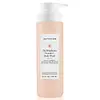What's inside
What's inside
 Key Ingredients
Key Ingredients

 Benefits
Benefits

 Concerns
Concerns

 Ingredients Side-by-side
Ingredients Side-by-side

Water
Skin ConditioningCocamidopropyl Betaine
CleansingGlycerin
HumectantUrea
BufferingSodium Methyl Cocoyl Taurate
CleansingAcrylates Copolymer
Panthenol
Skin ConditioningAvena Sativa Kernel Flour
AbrasivePhenoxyethanol
PreservativeHippophae Rhamnoides Fruit Oil
Skin ProtectingSodium Benzoate
MaskingCalendula Officinalis Flower
Skin ConditioningStyrene/Acrylates Copolymer
Sodium Chloride
MaskingRhamnose
HumectantXanthan Gum
EmulsifyingAllantoin
Skin ConditioningGlucomannan
Skin ConditioningXylitylglucoside
HumectantSodium Hydroxide
BufferingHelianthus Annuus Seed Oil
EmollientPotassium Sorbate
PreservativeAnhydroxylitol
HumectantCoco-Glucoside
CleansingXylitol
HumectantGlucuronic Acid
BufferingCoconut Acid
CleansingGlucose
HumectantInulin
Skin ConditioningCitric Acid
BufferingLecithin
EmollientPropanediol
SolventWater, Cocamidopropyl Betaine, Glycerin, Urea, Sodium Methyl Cocoyl Taurate, Acrylates Copolymer, Panthenol, Avena Sativa Kernel Flour, Phenoxyethanol, Hippophae Rhamnoides Fruit Oil, Sodium Benzoate, Calendula Officinalis Flower, Styrene/Acrylates Copolymer, Sodium Chloride, Rhamnose, Xanthan Gum, Allantoin, Glucomannan, Xylitylglucoside, Sodium Hydroxide, Helianthus Annuus Seed Oil, Potassium Sorbate, Anhydroxylitol, Coco-Glucoside, Xylitol, Glucuronic Acid, Coconut Acid, Glucose, Inulin, Citric Acid, Lecithin, Propanediol
Water
Skin ConditioningSodium Cocoyl Isethionate
CleansingCocamidopropyl Hydroxysultaine
CleansingGlycerin
HumectantCoco-Glucoside
CleansingSodium Methyl Cocoyl Taurate
CleansingSodium Hyaluronate
HumectantAcrylates/C10-30 Alkyl Acrylate Crosspolymer
Emulsion StabilisingAscorbyl Glucoside
AntioxidantPapain
Skin ConditioningNiacinamide
SmoothingBromelain
Skin ConditioningSodium PCA
HumectantVaccinium Myrtillus Bud Extract
AntioxidantSaccharum Officinarum Extract
MoisturisingCitrus Limon Fruit Extract
MaskingAcer Saccharum Extract
Skin ConditioningCitrus Aurantium Dulcis Fruit Extract
MaskingGlycol Distearate
EmollientPolyquaternium-51
Skin ConditioningCaprylic/Capric Triglyceride
MaskingCitrus Aurantium Amara Leaf/Twig Extract
Skin ConditioningPhenoxyethanol
PreservativeCocamide Mipa
EmulsifyingTriethyl Citrate
MaskingSodium Hydroxide
BufferingEthylhexylglycerin
Skin ConditioningUrea
BufferingTetrasodium Glutamate Diacetate
Trehalose
HumectantMaltodextrin
AbsorbentWater, Sodium Cocoyl Isethionate, Cocamidopropyl Hydroxysultaine, Glycerin, Coco-Glucoside, Sodium Methyl Cocoyl Taurate, Sodium Hyaluronate, Acrylates/C10-30 Alkyl Acrylate Crosspolymer, Ascorbyl Glucoside, Papain, Niacinamide, Bromelain, Sodium PCA, Vaccinium Myrtillus Bud Extract, Saccharum Officinarum Extract, Citrus Limon Fruit Extract, Acer Saccharum Extract, Citrus Aurantium Dulcis Fruit Extract, Glycol Distearate, Polyquaternium-51, Caprylic/Capric Triglyceride, Citrus Aurantium Amara Leaf/Twig Extract, Phenoxyethanol, Cocamide Mipa, Triethyl Citrate, Sodium Hydroxide, Ethylhexylglycerin, Urea, Tetrasodium Glutamate Diacetate, Trehalose, Maltodextrin
 Reviews
Reviews

Ingredients Explained
These ingredients are found in both products.
Ingredients higher up in an ingredient list are typically present in a larger amount.
Coco-Glucoside is a surfactant, or a cleansing ingredient. It is made from glucose and coconut oil.
Surfactants help gather dirt, oil, and other pollutants from your skin to be rinsed away.
This ingredient is considered gentle and non-comedogenic. However, it may still be irritating for some.
Learn more about Coco-GlucosideGlycerin is already naturally found in your skin. It helps moisturize and protect your skin.
A study from 2016 found glycerin to be more effective as a humectant than AHAs and hyaluronic acid.
As a humectant, it helps the skin stay hydrated by pulling moisture to your skin. The low molecular weight of glycerin allows it to pull moisture into the deeper layers of your skin.
Hydrated skin improves your skin barrier; Your skin barrier helps protect against irritants and bacteria.
Glycerin has also been found to have antimicrobial and antiviral properties. Due to these properties, glycerin is often used in wound and burn treatments.
In cosmetics, glycerin is usually derived from plants such as soybean or palm. However, it can also be sourced from animals, such as tallow or animal fat.
This ingredient is organic, colorless, odorless, and non-toxic.
Glycerin is the name for this ingredient in American English. British English uses Glycerol/Glycerine.
Learn more about GlycerinPhenoxyethanol is a preservative that has germicide, antimicrobial, and aromatic properties. Studies show that phenoxyethanol can prevent microbial growth. By itself, it has a scent that is similar to that of a rose.
It's often used in formulations along with Caprylyl Glycol to preserve the shelf life of products.
Sodium Hydroxide is also known as lye or caustic soda. It is used to adjust the pH of products; many ingredients require a specific pH to be effective.
In small amounts, sodium hydroxide is considered safe to use. However, large amounts may cause chemical burns due to its high alkaline.
Your skin has a natural pH and acid mantle. This acid mantle helps prevent harmful bacteria from breaking through. The acid mantle also helps keep your skin hydrated.
"Alkaline" refers to a high pH level. A low pH level would be considered acidic.
Learn more about Sodium HydroxideThis gentle cleansing and foaming ingredient is known for leaving a smooth feeling in skin and hair. It is made using coconut oil.
According to the manufacturer, it is soluble in water and has resistance to hard water, acid, and alkali.
Due to its coconut base, it may not be Malassezia folliculitis safe.
Learn more about Sodium Methyl Cocoyl TaurateUrea is also called carbamide and is the diamide of carbonic acid. In cosmetics, urea is used to hydrate the skin. It also provides exfoliation in higher concentrations.
As a humectant, urea helps draw moisture from the air and from deep within the skin. This helps hydrate your skin. Studies show urea is an effective moisturizer for dry skin conditions. 40% urea is typical in medications for treating eczema and other skin conditions.
Urea has the strongest exfoliation effect in concentrations higher than 10%. It is a keratolytic agent, meaning it breaks down the keratin protein in the top layer of skin. This helps remove dead skin cells and flaking skin.
In medicine, urea has been shown to help increase the potency of other ingredients, such as fungal treatments.
Humans and animals use urea to metabolize nitrogen-containing compounds. Urea is highly soluble in water. Once dissolved, it is neither acidic nor alkaline.
Learn more about UreaWater. It's the most common cosmetic ingredient of all. You'll usually see it at the top of ingredient lists, meaning that it makes up the largest part of the product.
So why is it so popular? Water most often acts as a solvent - this means that it helps dissolve other ingredients into the formulation.
You'll also recognize water as that liquid we all need to stay alive. If you see this, drink a glass of water. Stay hydrated!
Learn more about Water